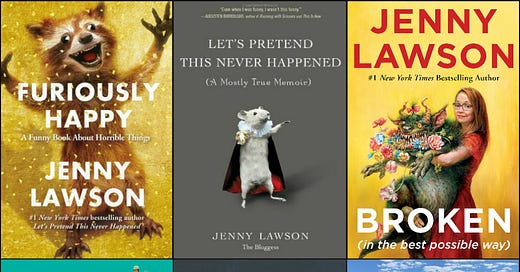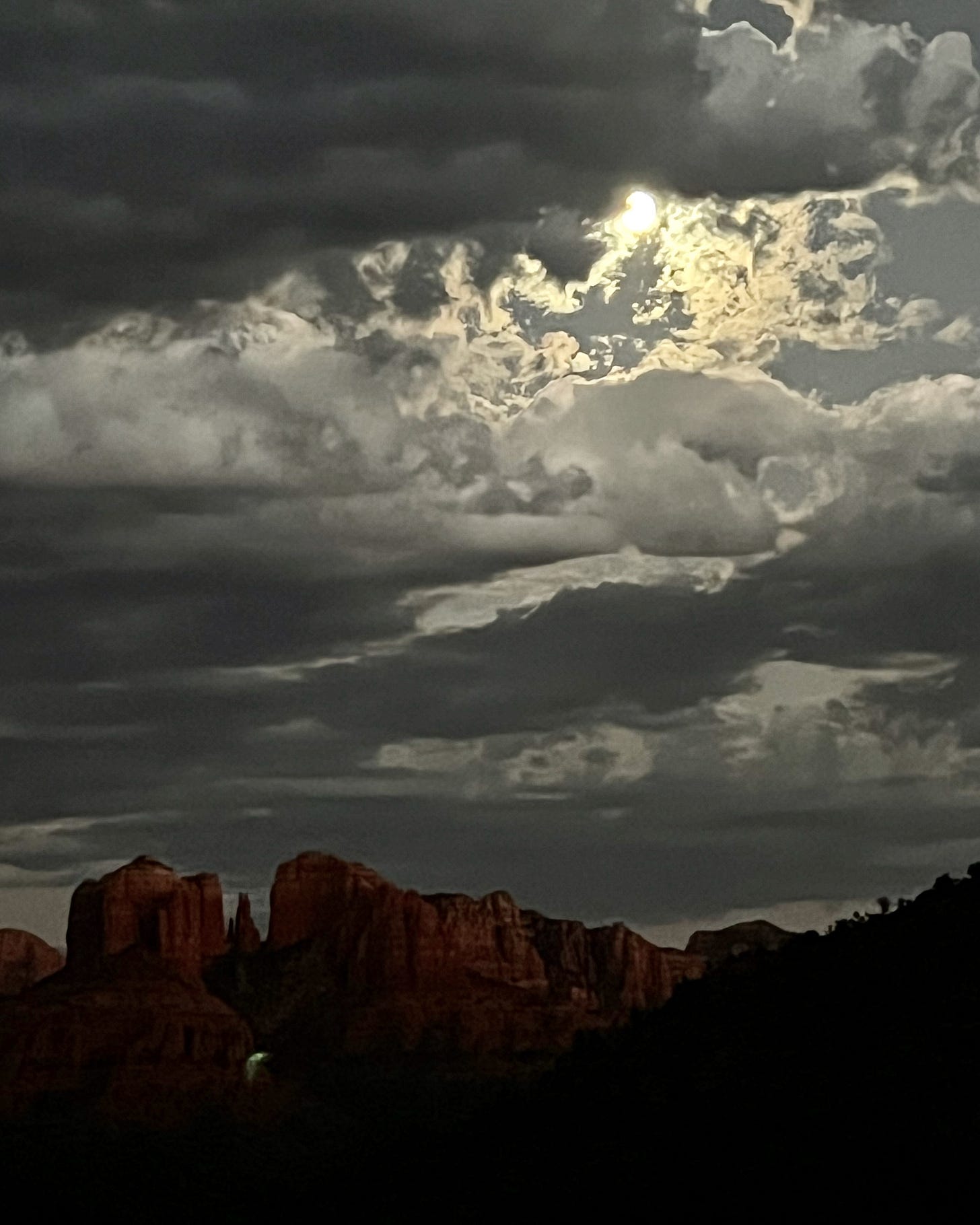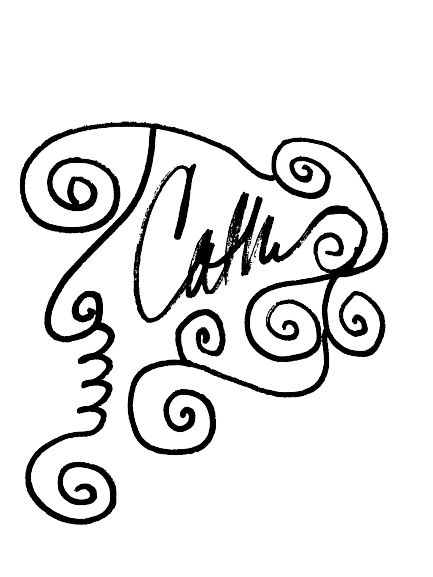My Favourite Things: September 8
Among this week's MFTs: Wonderful weirdness with Jenny Lawson on a long road trip, second-chance vortices in Sedona, Andō and the gift of silence, Wes Anderson's aliens and Episcopalians, and more.
These weekly My Favourite Things (MFT) posts are available as a premium to paid subscribers of all levels. If you’d like to upgrade to a paid subscription, you can do so with the button below. Today’s is available to all subscribers because I feel badly about having been away for so long.
If you cannot afford a paid subscription right now but would like access to the premium benefits of My Favourite Things and other paid-subscriber-only content, please email me at thisnuminousworld@gmail.com and I gladly will gift you a premium subscription.
Roadtripping with the wonderfully weird, whimsically wise, and hilariously honest stories of Jenny Lawson
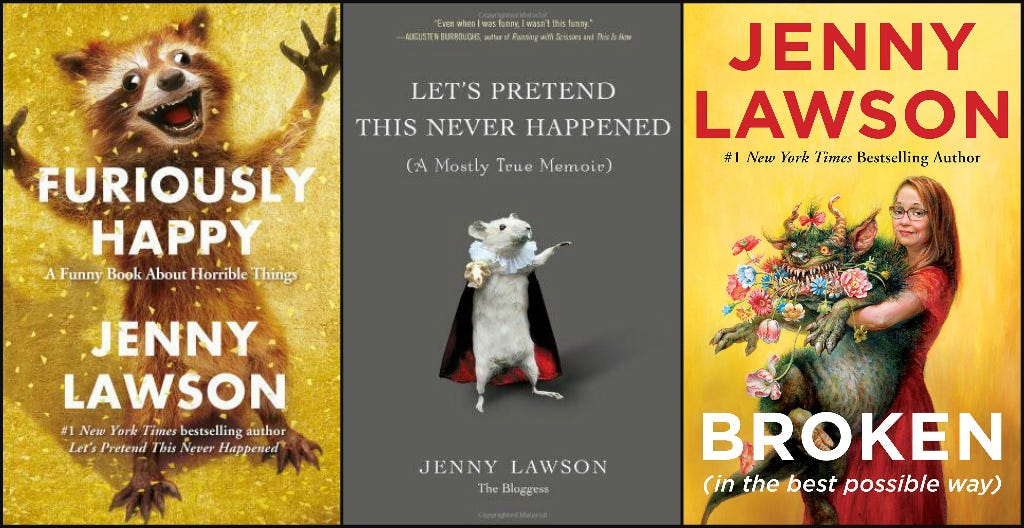
We were about five miles from our hotel in Cedar City, Utah when the story Jenny Lawson was telling about the armadillo purse (IYNYN) from her memoir Furiously Happy made me laugh so hard, I was crying, couldn’t see properly, and had to pull over on the shoulder of the interstate until it was safe again to drive.
“You were going 55 in an 80 zone,” my traveling companion, Melinda, would inform me later, after she stopped cry-laughing herself and we pulled into the Comfort Inn parking lot, wheezing and wiping our eyes. #armadildo
My hand to God, I cannot remember the last time I laughed THAT hard, with apologies to Marc Maron, whose set at the Largo a few months back had Melinda and me in stitches for three hours and left us with sore abs the next day. I didn’t think it possible, but Jenny made us laugh even harder than the Bob Weir line in Maron’s Grateful Dead concert story.
Lawson, who you might also know by her formidable and OG presence on the socials as The Bloggess, must be one of the funniest people on the planet.
She also has to be one of the most honest.
Whether she’s talking about her struggles with mental illness and a host of other physical ailments (I have just two of the autoimmune diseases she has and frankly I don’t know how she manages to get out of bed when she does), her long relationship with her misanthropic husband (and straight man in many of her stories) Victor, growing up economically challenged in rural Texas, motherhood, or the travails of being an author (even one as massively successful as she), Lawson never shines a turd.
She tells it like it is, warts and weird rashes and all.
📢 And. I. Love. Her. For. It. And. Everything. Else. 📢
I’ve known of Lawson for more than a decade and we share a few friends in common (hey grrl hey, Karen Walrond, Melinda can verify that I l i t e r a l l y screamed when Jenny first name-checked you in Furiously Happy), but it wasn’t until we pulled out of Laguna Beach on August 23 headed for Boulder to bring a carload of stuff that didn’t fit into my son’s car when he drove himself to college a few days earlier to his new home that we spun my Audible library roulette wheel, which landed on Furiously Happy, and the glory that is Lawson shone upon us.
We spent much of the next week and more than 2,500 miles listening to Lawson for hours, beginning with what is actually her second memoir, Furiously Happy, proceeding to her latest memoir, Broken (in the best possible way), and then going back to listen to her debut memoir, Let’s Pretend This Never Happened. We howled with laughter and had to pull over at least twice more for safety sake, including once at dusk near the 11,000-foot summit of the Million Dollar Highway outside Ouray, Colorado—a road that Google later told Melinda is considered one of the most dangerous in America because of its elevation and hairpin turns. We had sense enough to pull over before Jenny’s hilarity sent us careening over a cliff like Toonces the Driving Cat.
Speaking of Toonces, there’s an awful lot of taxidermy in Lawson’s books. A shit-ton, actually. And before passing so many hours with dear Jenny and her menagerie of taxidermized creatures (all of whom died of natural causes or were roadkill), I was not a fan. They always creeped me out a bit, even when I purchased the mounted head of a javelina for my chosen nephew, Willem, before he went off to college. (It was a nod to our shared love of all things Wes Anderson. See The Royal Tenenbaums for the javelina reference, and below for more WesAndo ardor.) Some of her stories are not for the faint of heart or those who are squeamish about animals in jeopardy (her father is a taxidermist as well as a rescuer of many animals, wild and domesticated, a trait he definitely seems to have passed to his daughter.)
I used to see taxidermy as maudlin, creepy, and even cruel. I’m no hunter and I loathe guns, so when we’ve occasionally rented a vacation house with mounted deer heads (and hooves) or a stuffed pheasant hanging above the fireplace, I’ve done my best to avoid their glass-eyed gazes. Now, after hearing many of her taxidermy tales, I, too, want a perpetually elated, jazz-handy stuffed raccoon like Rory, one of at least two Lawson owns and who graces the cover of Furiously Happy. Somehow, I imagine exploring the taxidermy offerings at a few local antique shops being on a list of upcoming field trips with Melinda as autumn approaches.
Lawson clearly has a huge, squishy, empathetic heart. For her pets, who have some of the best names ever, such as Hunter S. Tomcat and her papillon (who looks like she could be Stritchie’s cousin), Dorothy Barker, and for the opossums that seem to follow her through life like the hound of hell, playing dead at her heels or tumbling from a tall branch into her swimming pool while she’s floating in it, and for the people she encounters, and for herself. That last part is the hardest part for most of us, including Lawson, but she manages to love herself in all her beautiful brokenness. It’s an example I strive to emulate and a compassion I would like to spread throughout my own little world.
Many of you likely know Lawson’s work and got to her memoirs long before I did. For those of you who have not, I urge you to seek them (and her) out. There aren’t many of us who are brave enough to tell the truth about ourselves and our world like she does. She’ll make you laugh, but she’ll also make you think, and she might also bring you to tears. If you’re struggling with mental and physical ailments, she’s a great one to ride shotgun on your journey through the ups and downs and sideways of illness.
Just … if you’re listening to her in the car, make sure there’s a shoulder available to pull off onto, because you’ll likely need it. Also, have some Kleenex handy for tears of all varieties.
Jenny, if you happen to read this, this is me typing a deep bow and awkward curtsy of gratitude for you, your heart, stories, and moxie. We love you. Please keep going.
You can find Ms. Lawson on Instagram and on the X formerly known as Twitter before Elmo the Evil Clown sucked the life force out of it like an anti-Semitic semi-human version of the dehydrate setting on an InstaPot.
You can also find her at the very cool bookstore that she opened, if memory serves, in the middle of COVID (like ya do), Nowhere Books in San Antonio. If you’re thinking about ordering one of her books, maybe throw her independent bookstore a little business instead of feeding the empire?
Asteroid City | Wes Anderson, Aliens, and Episcopalians
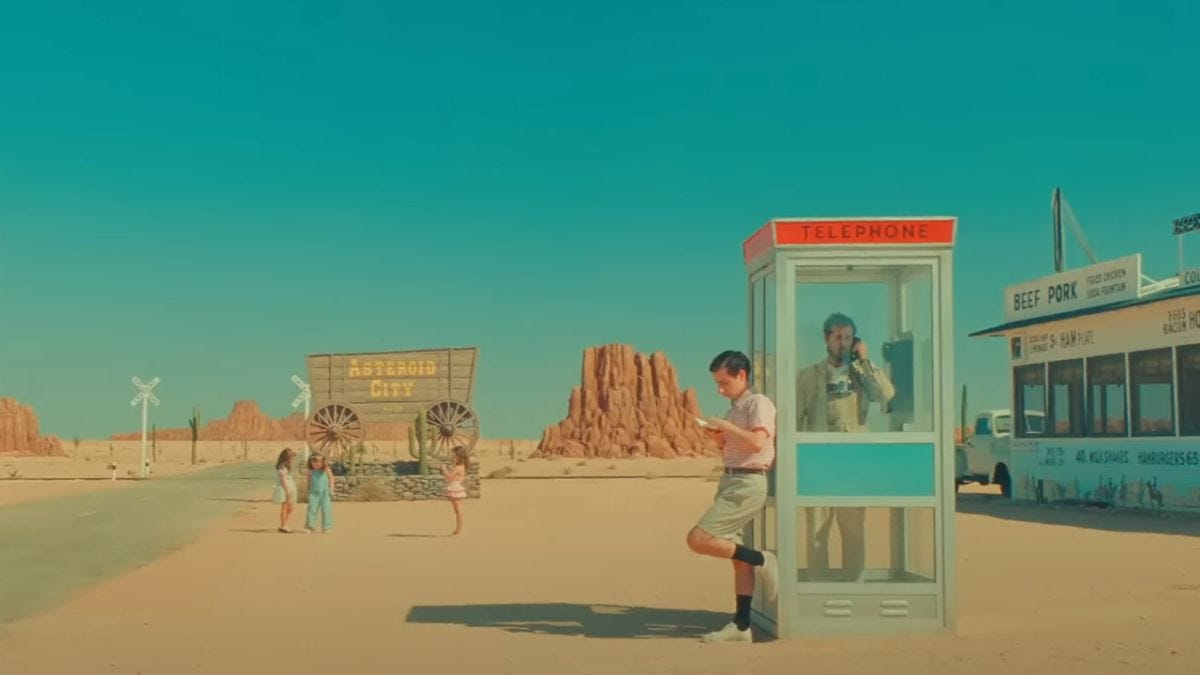
As you likely know already, I’m an ardent and longtime fan of Wes Anderson.
While Asteroid City would not be one of my top favourites among his remarkable oeuvre, it hasn’t stopped me from watching it several times since its release earlier this summer. I didn’t love the story, but I did love how the film looked and, ultimately, the rich ambivalence with which it left me.
It was unsettling and puzzling. Perhaps that was the point.
For nothing happens in Wes World by accident. It’s all elaborately planned like a fantastical nine-course dinner party, where even the smallest detail is purposeful and prepared with the greatest of care.
Asteroid City is something of an oddball, even for Anderson. But there are themes in the film that will be familiar for fans and/or students of his filmography. Estrangement and fractured family systems, ennui/Weltschmerz/acedia and the perpetual search for meaning beyond superficial symbolism. A yearning to have faith in something (or someone) and how God (or the divine or the whole of the universe) resides in the details—sometimes literally.
Anderson is rarely explicitly spiritual (Darjeeling Limited being an obvious exception), but in Asteroid City there are recurrent themes of aliens/alienation, Epsicopalianism, the allure/complexity of what appears to be simple faith, and existential crises.
The writer/director/auteur attended an Episcopal high school, where if the faith tradition didn’t leave an indelible impression, it certainly seems to have winged him enough to exert an influence, however subtle, on his work over the years.
Anderson’s Rushmore was filmed at the private Episcopal academy, St. John’s School in Houston, which the director himself attended. There is an ongoing conversation, however implicit and very Epsicopalian, about faith and reason, religion and science, throughout his films, and pretty vividly represented in Asteroid City.
Religion or a belief in something beyond this world (whether it’s God or life elsewhere in the universe) is a running joke in Wes World. But I have a suspicion it’s not entirely meant to be funny.
In a fake interview for a faux Italian talk show that Anderson and his oft-collaborator Noah Baumbach recorded a decade or so ago and that was included in the Criterion Collection version of The Life Aquatic with Steve Zissou (one of my favourites), the faux Italian talk-show intervistatore, Antonio Monda, asks Baumbach if he believes in God, to which he answers quickly, “No.”
What about you? the interviewer asks Anderson.
“I think so,” Anderson answers, “I mean, roughly.”
God. Roughly.
Yes. That.
There’s a lot of that feeling about a belief in God, roughly, present in Asteroid City, a film about a play of the same name. The documentary-ish portion of the film, about the playwright, Conrad Earp (Edward Norton), the backstory of the play and the film are presented in black-and white, while the film of the play is shown in color. In it, Jason Schwartzman plays the actor Schubert Green playing the character in the play and the movie version of the play called “Augie Steenbeck,” a war photographer and father of four who has just lost his wife but, at the beginning of the film, has yet to tell his children. When he does at the urging of his father-in-law Stanley Zak (Tom Hanks in a role that feels like it should have been played by Anderson stalwart Bill Murray), he finally sits his children—seven-year-old triplet daughters, Andromeda, Pandora, and Cassiopeia, and tweenage son, Woodrow—down by the side of the dusty desert roadside attraction that is Asteroid City and delivers the news.
AUGIE: You’re probably wondering why we didn’t pack your mother’s suitcase.
It’s because she’s not coming with us on this journey.
She can’t come.
She got too sick.
And, to put it bluntly, after all the surgeries, therapies and interventions…after two years of struggling and suffering, she succumbed to her illnesses.
I’m sorry. I didn’t know how to tell you then. I couldn’t figure out how to tell you later.
I didn’t know what to do. The time was never right.
WOODROW: You’re saying our mother died three weeks ago?
AUGIE: Yes.
DAUGHTER: When is she coming back?
AUGIE: She’s not coming back.
Let’s say she’s in heaven. Which doesn’t exist for me, of course, but you’re Episcopalian.
Come here. Let me hug you.
Okay. Sit back down.
Did you know already, Woodrow?
WOODROW: I think so. She’d been away so long.
AUGIE: We’re gonna be okay.
Your grandfather’s on his way.
We’re gonna stay with him for a period of time which is yet to be determined how long it’s gonna be.
DAUGHTER: Is she in there?
AUGIE: Yeah. She’s in the Tupperware.
After the news, delivered in an abrupt stilted manner that all of the dialogue in the film is presented (an obviously deliberate, if inexplicable, choice by Anderson), the triplets create their own ritual for burying their mother’s ashes (in the small, blue, burp-able covered Tupperware bowl) in a nod, I’d imagine, to Hamlet’s three witches.
The plan is for Zak to take the four Steenbeck children back with him to his golf-course-adjacent mansion in Palm Springs. Later in the film, after an actual alien makes an appearance, stealing the asteroid that is the feature of the eponymous roadside attraction, there’s an exchange between grandfather, father, and grandson that speaks to the kind of existential angst that is Anderson’s bread-and butter.
ZAK: I can actually carpool the girls to school by golf cart, you know. If I cut across the 14th tee.
AUGIE: Oh, it’s that close to the elementary?
WOODROW: How can you two even think about this? The world will never be the same. What happens next? Nobody knows. Will he visit us again? Will he speak to us? What will he say? Why did he steal our asteroid? Was it ours in the first place? Does he like us? Nobody knows.
AUGIE: That’s true.
WOODROW: What’s out there? Something. The meaning of life. Maybe there is one.
ZAK: I hope you’re still Episcopalian.
WOODROW: You took his picture, Dad.
AUGIE: I’m a photographer.
WOODROW: (whispers) Episcopalian?
AUGIE: You really want us, Stanley?
ZAK: No, but you need me.
AUGIE: She did love me, you know.
ZAK: Who says she didn’t? I’ve been on my own for 12 years, after all. And remember, my wife drank herself to death.
AUGIE: “Drank herself to…” I don’t know what that means.
ZAK: In my loneliness, or perhaps because of it, I’ve learned not to judge people, to take people as I find them, not as others find them, and most of all, to give complete and unquestioning faith to the people I love.
I don’t know if that includes you, but it included my daughter and your four children, so you’re welcome to stay with me for as long as you wish, whether I like it or not. Which I don’t, by the way.
AUGIE: Stop helping us. We’re in grief.
ZAK: Me, too.
WOODROW (to his father): Are you planning to abandon us?
AUGIE: Uh… I was, as a temporary measure.
ZAK: What?
AUGIE: But I decided against it.
WOODROW: I knew it. I sensed it.
AUGIE: I didn’t.
ZAK: I’m not the wet nurse. I’m their grandfather.
AUGIE: I would’ve hired a babysitter in addition to you. I’m not planning to abandon you anymore, even as a temporary measure, which is all it ever would’ve been.
WOODROW: I forgive you for considering it.
Perhaps the most explicit (and eloquent) of Anderson’s spiritual pondering in Asteroid City, comes in an exchange that takes place in the black-and-white “real” world, where Jones Hall (aka “Augie Steenbeck”) leaves the set of the film to track down the director, Schubert Green (Adrien Brody) who’s backstage in the theater sleeping on a cot when his actor/creation interrupts him. He’s having an existential/creative crisis and he’s got questions.
JONES HALL: I feel lost.
SCHUBERT GREEN: Good.
JONES: He’s such a wounded guy. I feel like my heart is getting broken, my own personal heart, every night.
SCHUBERT: Good.
JONES: Do I just keep doing it?
SCHUBERT: Yes.
JONES: Without knowing anything?
SCHUBERT: Yes.
JONES: Isn’t there supposed to be some kind of an answer out there in the cosmic wilderness? Woodrow’s line about the meaning of life—
SCHUBERT: “Maybe there is one.”
JONES: Right. Well, that’s my question—I still don’t understand the play.
SCHUBERT: Doesn’t matter. Just keep telling the story.
And in a blink-and-you’ll-miss-it moment before Jones reaches Schubert in the “real world” of the black-and-white theater, the actor walks by a makeup station where the alien (played by Jeff Goldblum ostensibly playing himself as the actor playing the alien) is telling his dresser about his character.
THE ALIEN: I don’t play him as an alien, actually. I play him as a metaphor. That’s my interpretation.
JONES: Metaphor for what?
THE ALIEN: I don’t know yet. We don’t pin it down.
A metaphor for what, indeed?
Yes, Asteroid City is imperfect, but it is also more than meets the eye on first viewing. If you’re so inclined, perhaps, as I did, give it a second chance.
Just keep telling the story…
Bill Murray, who has appeared in every other Anderson film except his debut, 1996’s Bottle Rocket, does not appear in Asteroid City. Reportedly, he was meant to play the motel manager, but a bout of COVID-19 kept him from playing the role that ultimately went to Steve Carrell. The film misses his presence. Carrell does a fine job in the role that Murray was cast to play, and Hanks makes a good show of the role that, IMHO, should have gone to Murray.
Ever a trickster and team player, Murray did manage to film a short that was released online to accompany Asteroid City, in which he plays the actor Tab Whitney, who was, he tells us, meant to play the character of Jock Larkings, an aerospace titan. It’s quintessential Murray/Wes World.
Here it is:
Here are few of my earlier scribblings about Wes Anderson and his film oeuvre:
Second-Chance Sedona (I get it now.)
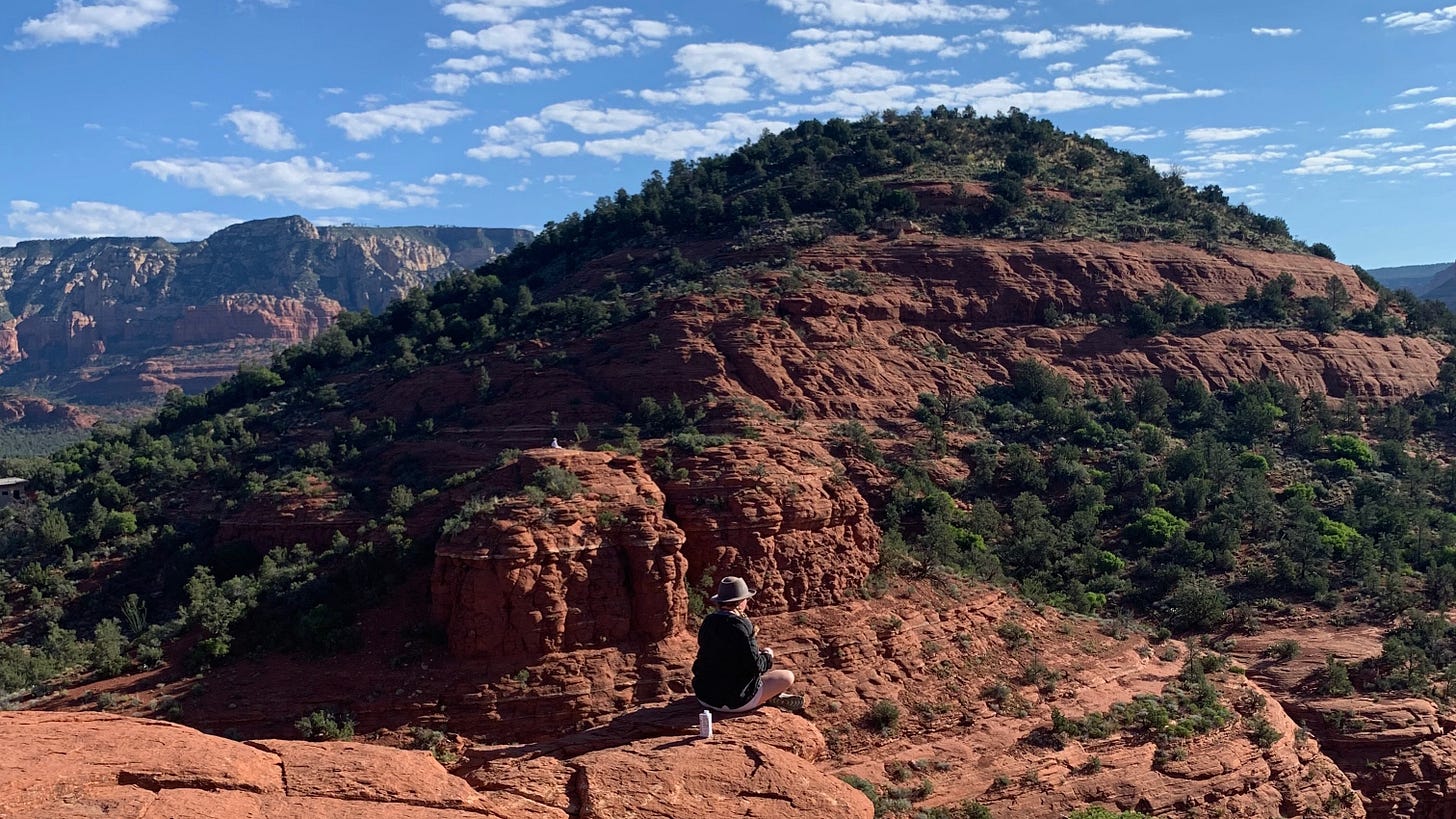
Last summer, on my way to Albuquerque for the final meeting of my cohort of The Living School, I spent a day and night in Sedona, because countless people in my life have told me for years that I had to visit Sedona because it was soooooo me. Well, it was soooooooo not me the day I was there, when it was chock-a-block with tourists and about 115 degrees in the shade. I had wanted to hike but didn’t want heat stroke so that was out, and while I have been known to enjoy retail therapy, there are only so many crystals and so much goddess wear one sweaty human candle can take. I retreated quickly to the AC of my hotel room and in the 30 minutes between the barometric pressure dropping along with the temperature and the start of the intense monsoon rains, I read a book by the pool. (A very good book, I might add. Here’s a terribly belated shout-out and recommendation for Isaac Fitzgerald’s Dirtbag, Massachusetts, as well as his wonderful Substack, Walk It Off.)
I arose early the next morning, eager to get the hell out of … well, Sedona. I did stop long enough to visit the truly beautiful Chapel of the Holy Cross just as it opened and fled as scores of other tourists arrived. Later in the week in Albuquerque, when friends asked how I liked Sedona, my answer was “meh.”
So, last week, when Melinda and I were wending our way back to California from Boulder after getting Vasco situated in his new student housing and saying my proud/tearful goodbyes to my only child, we decided to head to Sedona again, because she loves it and said I just hadn’t done it right the first time.
Melinda was, as she often is, absolutely right. We arrived in the early afternoon, in time for me to get settled and join my first Zoom class in the two-year spiritual direction certification program I’ve just begun through the Institute of Pastoral Studies at Loyola University in Chicago. When that was done, we set out in the cool of the evening to an outcropping off of Red Rocks Road where we watched the sun set and moon rise behind Cathedral Rock.
It was breathtakingly beautiful and so quiet.
The next morning, we arose early to beat the heat (it was to top 100 degrees by late morning) and headed to one of Sedona’s fabled vortices. What is a vortex, you ask? Good question. It sounds woo-woo and it is, but that doesn’t make it any less real. (I will not debate the definition of “real” here today.) Suffice to say, a vortex or vortices are places that my ancient Celtic ancestors might have dubbed “thin places”—where the veil between the material world and the spirit world is gossamer thin. A vortex is believed by those who are so inclined to be a sort of gathering place of spiritual power that can be conducive to healing and spiritual enlightenment.
In other words, there’s a vibe in Sedona’s vortices, and while I can be a skeptic, when Melinda and I climbed up to the flat(ish) rocks at the underwhelmingly named Airport Mesa Vortex, we could feel it.
Wordlessly, she went her way, and I went mine to find a place to sit and do nothing. There were maybe a dozen other people in the same area, everyone maintaining silence and respect for the place and the experience they and others were having. I meditated for I’m not sure how long, maybe 30 minutes, maybe less, but it was one of those meditative experience where I dropped in almost immediately, as soon as I closed my eyes and took three long breathes. Boom. I was there. In that place. The place you can’t really describe to anyone else, but you know it when you find it. (The photo at the top that of this section is me settling in, if memory serves. I was futzing with the camera on my phone, about to put it down and just … be.)
There is something to the Sedona vortices. Some say the whole town is a vortex. That was not my experience the last time and even this time. I don’t know that I felt anything different when I went to pick up notebooks at the local Staples or when we shopped for groceries at the Safeway, but we did feel it, palpably, back at a small resort where we ended up staying. I found it last minute via Booking.com and I cannot recommend it highly enough. It’s called Sedona Pines, right off the main drag on your way into town from the south, and it was about $100/night for an individual casita with ample AC, a comfy bed and soft linens, a full kitchen and bath, outdoor grill, and side porch. The complex had two outdoor spas and a heated salt-water swimming pool, where the second night, Melinda and I ventured out after dark to watch the Blue Moon rise. It was heavenly. (Just maybe try to avoid the invitation to speak to the guy stage right of reception who, we surmised, was there to tell you about the features of the resort and perhaps interest you in a timeshare.)
But seriously, Sedona Pines is truly a gem. If you’re heading to Sedona’s vortices, check it out. Sometimes they have live music by local musicians, including an indigenous flutist who was set to play the night of our departure, and a massive collection of films on DVD (we had two televisions in our casita, both with DVD players—we ended up borrowing the original Willy Wonka and The Grand Budapest Hotel as Minna had never seen it all the way through). Oh, and then there’s the huge, tidy laundry room where everything was free. We headed home to California with bags full of clean clothes. 🙌
Ergo, the moral of this story is, second chances are a thing for good reason. And second-chance Sedona held unexpected gifts and memories for me that won’t soon be forgotten.
Andō and the Gift of Silence

I don’t recall how I first came across Andō, but I do know it was early in the COVID era because by the middle of April 2020, I had signed up for her online course in contemplative poetry.
Then, as now, Andō’s gift of stillness—of quiet itself—soothed me. As the world spun further into chaos, her “offerings,” whether it was that wonderful poetry course called “Small Silences” (which you can find HERE), in her social media posts that appeared like the Spirit’s still small voice amidst the hurricane and earthquake of our societal turmoil and vitriolic public square, or in the occasional one-on-one spiritual direction sessions we’d have via Skype or Zoom from wherever she was at the time—Portugal or England or some quiet, simple corner elsewhere—were life-giving to me and countless others around the world who happened upon this humble Zen/Christian/Buddhist/uncategorize-able contemplative and mystic. She also has no small part part of why I’m presently a first-year student in the spiritual direction certification program at Loyola University in Chicago. (Go Ramblers!)
Andō hosts online silent meditation sits weekly, at 12:00 and 16:00 London time/UTC, which you can find more information about HERE.
And she also has a wonderful presence on here on Substack called Silentium.
Might I suggest you wander over and join her in the gift of silence.
If you are looking for a spiritual director/spiritual companion, I cannot recommend Andō with more gusto. You can schedule online sessions with here HERE.
Deep bows of gratitude, my friend. 🙏 📿🧘🏻
SPEAKING OF SILENCE AND FAVOURITE THINGS…
New Camaldoli Hermitage in Big Sur—perhaps my happiest of happy places and favourite spot in all of California—is open again to visitors and overnight guests after many, many months of being closed off from the rest of the world due to mud and rockslides on Highway 1 (Pacific Coast Highway) early this year.
I will be heading up there myself in the next few weeks to see the monks and sit in the silence and breathe the air and sit and look and wonder and ponder for a few days before the next (and final, TBTG) phase of treatment for Lyme disease keeps me grounded out home for two months.
If you have the inkling or urge to visit New Camaldoli, do it, even if you must drive all the way to the north side of Big Sur and drive south to reach it as I will, (because entry from the south on Highway 1 remains blocked due to damage that occurred during storms in February that CalTrans still is working to repair.) It’s worth it and the community of wonderful Benedictine monks who live and work and love you there can use the company.
Learn more and check for availability in the guest house or individual hermitages HERE.
I wrote about New Camaldoli a while back HERE.
THE STUFF AT THE BOTTOM OF THE POST
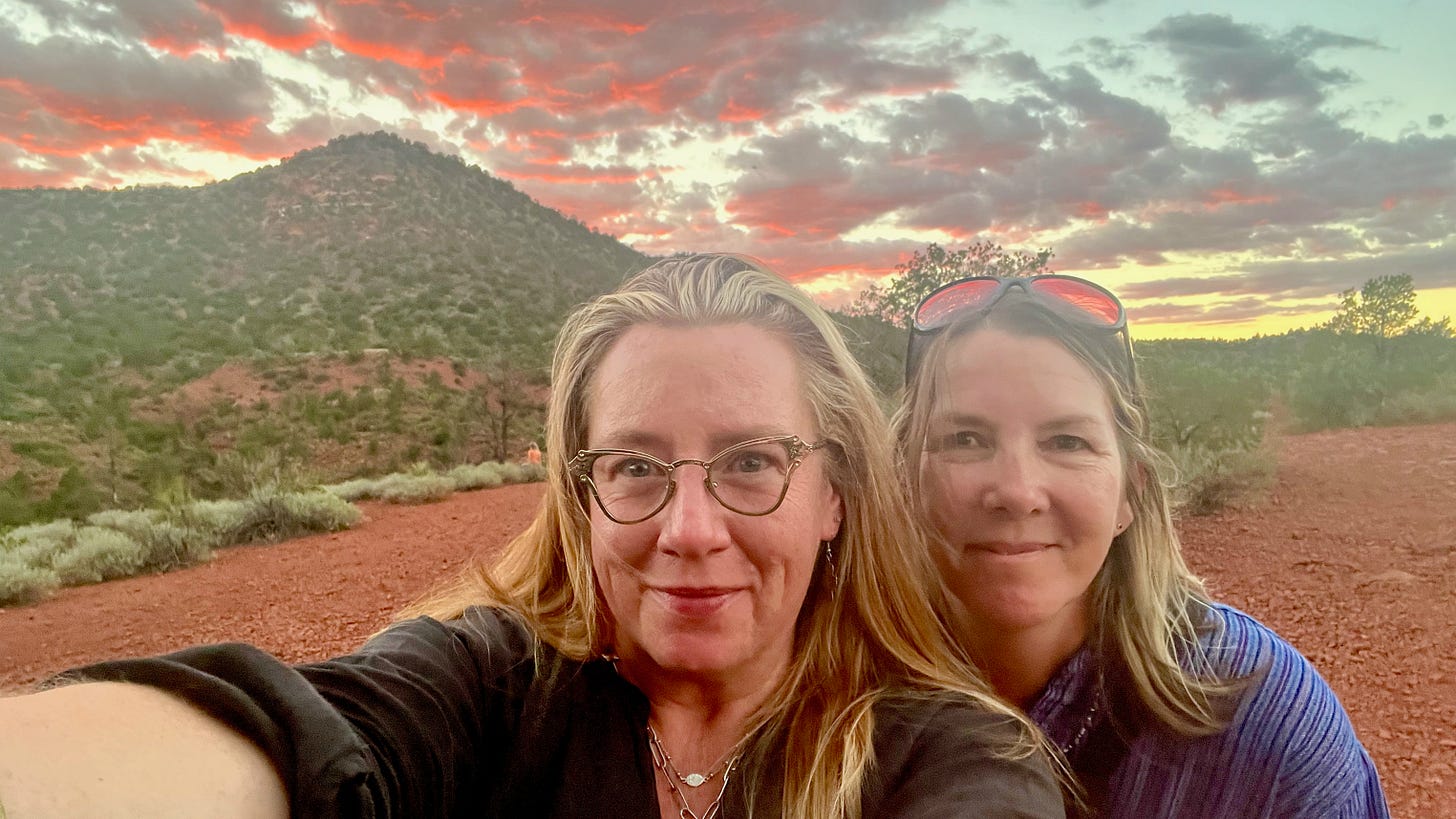
A note about paid subscriptions
Earlier this month, I added this MFT (My Favourite Things) feature exclusively for paid subscribers. To those of you who have become paid subscribers, thank you most sincerely. Your financial support is hugely encouraging and helps enable me to spend more time creating content for this community.
I realize paid subscriptions are not feasible for some folks. If you cannot afford to subscribe but would like to have access to the premium content behind the paywall, I don’t want finances to be a barrier for anyone in this community.
As I mentioned at the top of this post, if this is your situation, please send me a note at thisnuminousworld@gmail.com and I’ll hook you up.
If you’d like to donate a paid subscription for someone else, please email me at thisnuminousworld@gmail.com and I’ll send you a special link.
Or you may gift a paid subscription to whomever you’d like by using the following button:
Refer a Friend
Substack HQ recently rolled out the new Refer a Friend program to help us authors grow our readership and communities.
How it works:
1. Share This Numinous World. When you click on the button below, it should take you to a page with a link that’s specific to you and that you may copy and share with friends via text, email, on the socials, or hand-calligraphed notes fastened to the ankle of your favourite carrier pigeon, etc.
2. Earn benefits. When friends use your referral link to subscribe (free or paid), you’ll receive special benefits.
If you refer a single new reader to This Numinous World and they subscribe for free or at any paid level, you will get one month of a premium paid subscriber access.
If you refer five new readers and they subscribe at any level paid or free, you will get six months of a paid subscription.
If you refer 10 new readers and they subscribe at any level paid or free, you will get a year’s paid subscription for free.
If you already are a paid subscriber, first of all THANK YOU. When you refer folks and they subscribe at the above levels, I’ll add the corresponding months and/or year to your existing subscription.
To learn more, check out Substack’s FAQ.
Sorry for my absence in these parts the last month. We had a load of various dramas/traumas/urgencies/emergencies in the family that required attention and then there was the ghostwriting book manuscript, which was a fulfilling and exhausting experience. I’m back now. Thank you for your grace and patience during my unexpected time away from this space.
OK, so, let’s be brave and kind.
Remember you haven’t met yet everyone you will love, and you haven’t met yet everyone who will love you.
And if you ever find yourself driving-while-laugh-crying on an interstate highway, please pull over until it passes.
Much love from me,

